Aisles of Miles: Birth, Boxes, and Bootlegs
Something Old, Something New, Some Things Borrowed, All Things Blue
The Curse of Abundance
When I started working at a Sam Goody record store as a high school sophomore, the only direction I received was essential cash register operation—no other training, cheat sheet, or employee manual. Given our corporate overlords' bland approach to salesmanship, even if there had been an employee manual, the instructions on jazz might have looked something like this:
What To Do If a Customer Asks For a Jazz Recommendation
Members of the Sam Goody team should be prepared to assist customers with their requests for any music, even if it isn’t for Michael Jackson, Prince, or Madonna. For example, you may be approached by a customer seeking help selecting a jazz album for an upcoming dinner party. Our corporate jazz recommendation guidelines have been meticulously developed by our Accounting and Human Resources Departments, none of whom have ever been invited to a party, but have some expertise with eating dinner. Alone.
Step #1: Maintain your composure! Remember to thank the employee for shopping at Sam Goody and remind them that Goody’s Got It!
Step #2: Ensure they are not, in fact, at your Sam Goody location to purchase a Michael Jackson, Prince, or Madonna record. Once you’ve confirmed that they are shopping for jazz, recommend Miles Davis’s ‘Kind of Blue.’
Step #3: Stick with Step #2, even if you know the name of another jazz album. Then suggest that the customer consider purchasing a Michael Jackson, Prince, or Madonna album for post-dinner dancing.
In hindsight, things weren’t that shallow. Co-workers helped me up the Miles Davis learning curve: Milestones, for instance, also works well for dinner party jazz music. Live-Evil, on the other hand, not so much, unless your guests have overstayed their welcome and it’s time for them to depart. It became apparent that Miles Davis had many styles across an extensive catalog, and I had a LOT more to learn. Not only did I need to know about Miles and his music, but I also needed to learn how to ask better questions when making music recommendations. Given my role as an alleged Sam Goody expert, it seemed a reasonable goal to appear less confused about jazz and Miles Davis than my customers.
CDs were entering the market then, which presented new challenges in navigating the Miles Davis catalog over the following years. Remasters, remixes, bonus tracks, complete label collections, boxed sets, and anniversary editions expanded the question from “Which album?” to “Which album and what version?” With the arrival of streaming and download platforms, the challenge grew from a problem to a mess and, ultimately, a curse.
I’m not sure which is worse—dealing with a snarky, know-nothing/know-it-all high school sophomore at a record store or the shitty search engines and inscrutable metadata quirks of digital services. Let’s begin with a non-Miles example. Imagine a jazz novice curious about the legendary John Coltrane album, A Love Supreme (happy 60th anniversary!), and decided to search for it on Spotify. Here’s the search result as of Thankgiving 2024:
Running a similar search for Miles Davis’s Kind of Blue returns three options on Spotify. Two are legit; one is a grey market release (which sounds terrible, and none of the revenue goes to the proper rightsholders). Of the legit releases, one is the album as initially issued, and one is fleshed out with all sorts of bonus material. Where do you begin if you’re a Miles newbie flying without a co-pilot?
Why this happens and how to fix it are simple questions with complex answers that would take several posts to sort out. Streaming services are likely to confuse the curious, and it can be difficult to distinguish fact from fiction in a holiday "buyers guide" that aims to sell rather than provide clarity. Since digital platforms continue to fall short with credits, liner notes, and context, let’s focus on demystifying the fascinating (and excellent) trio of new Miles Davis collections that have come to market in Q4 2024. There always seems to be something “new” emerging from the Miles Davis vaults, and it’s easy (and often reflexive) to ignore, overlook, or cynically dismiss so much music in the age of abundance. However, all three of these releases depict Miles initiating a significant shift in jazz, a practice he would continue throughout his career. This necessitates asking questions that go beyond the superficial marketing hype. What’s the origin and nature of this music? Is it legit? A cynical label cash grab? A “bootleg” release of dodgy quality from a country where copyright isn’t adequately policed? Is this Miles music for fans or casuals? Where does this music fit in the history and mystery of Miles Davis? Do you need to hear it or own it?
Miles in Perpetual Motion

There’s a common thread linking all three of these Miles releases. Each is a snapshot in time capturing Miles in a moment before a milestone:
Miles ‘54 collects the five sessions he recorded that year for Prestige with assorted hard-bop royalty such as Sonny Rollins, Thelonious Monk, Art Blakey, and Horace Silver. With Miles assuming the role of bandleader, he was prepared for the offer he received the following summer to form a permanent group—his First Great Quintet—and sign with Columbia Records.
Birth of the Blue captured the nascent Miles Davis Sextet in May 1958, only ten months before they’d record Kind of Blue—the best-known and best-selling jazz album in history.
Miles In France 1963 & 1964—Miles Davis Quintet: The Bootleg Series, Vol. 8 is the eighth volume in Legacy Recordings’ ongoing Miles Davis Bootleg Series. It showcases Miles & Co. in the year leading up to (and including one of the first gigs by) Miles Davis’s Second Great Quintet.
Miles ‘54: The Prestige Recordings
Chronologically, the Miles ‘54 box comes first. This release commemorates the 70th anniversary of these sessions and the 75th anniversary of Prestige Records, though its value supersedes all the celebrations. These 20 tracks, recorded over five sessions in 1954, saw their release between 1954 and 1959. Obtaining original Prestige pressings in excellent (or even playable) condition is costly. Despite previous reissues in various Prestige Miles boxes, Miles '54 stands out in a few key areas, making it a worthy consideration.
I love the packaging. A sturdy box with a lift-off top houses the four 12” LPs. Each album is in a rice paper inner sleeve within a glossy jacket, the front of which is adorned with a color corresponding to the LP number, and the back contains a photo and track listing. The box has a slim pocket in front of the LPs housing the 8”x 8” booklet, which also serves as the color swath backdrop for the “'54” adorning the front of the outer box. Liner notes are by jazz authority and Miles Davis expert Ashley Kahn, and they are informative and compelling reading. Ashley makes many key points about where Miles was in his life, career, and artistry, creating a clear picture of the launch pad for the formation of Miles’s first famous small combo. Ashley also draws one’s ear to listen for the most crucial transformation afoot here—Miles moving from a working player and talented sideman to a confident bandleader and evolving jazz visionary. The booklet also includes a reproduction of the sleevenotes for Chronicle: The Complete Prestige Recordings, 1951-1956 by the late Dan Morgenstern, who flew from the world this past September. That collection was released in 1988, but Dan’s notes on each session remain relevant and fascinating. I’m pleased Craft went the extra mile (and expense) in their decision to include them here. Nice bonus!
I chatted with Ashley the other day, and he mentioned additional commentary about this music he enjoyed but could not fully explore in his notes. He suggested they’d be worth including here, and after reading them, I 100% agree:
I appreciate the chronological presentation of the music, as it enables you to witness the growth, adaptation, and maturity of Miles (and his sidemen) throughout the year—a strategy that Craft has successfully employed in previous Miles and Coltrane collections. Grammy winner Paul Blakemore's remastered sound is excellent, and a superb vinyl cut by Kevin Gray enhances his work. This terrific package sent me into a listening spree of early Miles—admittedly, a period that I don’t explore very often. Sometimes, a fresh presentation of old material can significantly enhance the experience. Here’s the complete session and track breakdown from Miles Davis Discography—session index, and here’s an excellent video getting into the weeds from the insightful and always entertaining Jazz Bums:
Birth of the Blue: What’s Old is New Again. Really.
I attended a playback session for Miles Davis's Birth of the Blue at All Blues Musiquarium on their KILLER sound system. This rig sounded incredible. Between the speakers and the atmosphere in the room, everyone was laser-focused on the new mixes of the four tracks comprising Birth of the Blue.
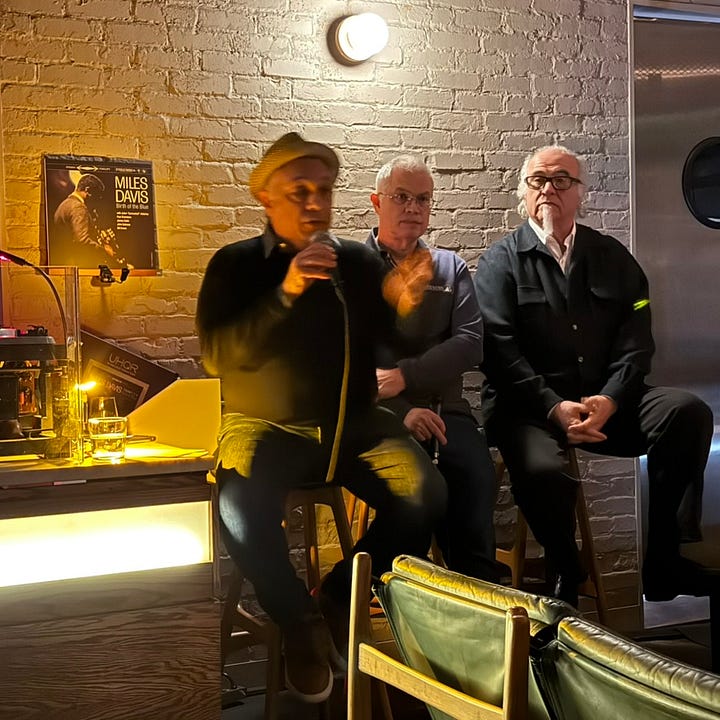
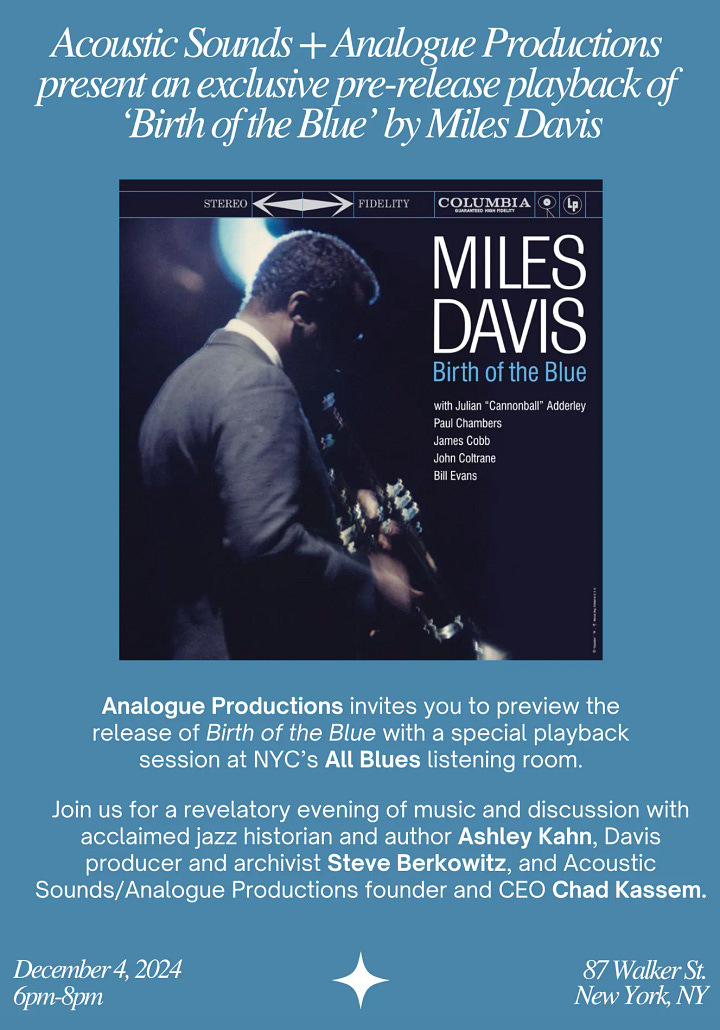

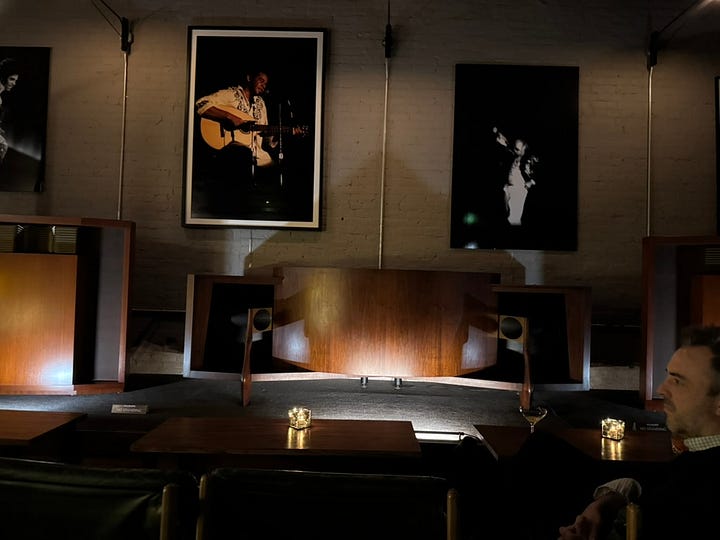
Credit to Shorefire, the publicity team behind Birth of the Blue, for choosing both venue and panelists. Each panelist made several notable points, leaning into their area of expertise. Ashley Kahn gave fantastic political, cultural, and musical context. Steve Berkowitz discussed the production, microphone placement, 3-track recording techniques, and Columbia Records 30th Street Studio's characteristic sound. Chad Kassem spoke in detail about the process of remixing the music from the original master, the pressing process, the unique Stoughton jacket, and how he spared no expense in making this release memorable. Chad’s Analogue Productions produced a short video combining all of these points:
I have seen some online criticism about the choice of title, font, and artwork to “trick” people into thinking this is a collection of Kind of Blue rehearsals, outtakes, or works-in-progress. To be clear, I don't view the marketing choices as particularly sinister, even though the video's hyperbole content goes a little further than necessary.
Birth of the Blue is four tracks recorded in May 1958 by the Miles Davis Sextet that would famously record Kind of Blue several months later. John Coltrane (tenor sax), Cannonball Adderley (alto sax), Bill Evans (piano), Paul Chambers (bass), and Jimmy Cobb (drums) had only been together for a few weeks, but you’d never know that when listening. The album presents the four tracks in their recorded order, with three ballads and a much-needed uptempo "Love For Sale" to give the rhythm section a chance to rock out. This relatively short album, clocking in at just over half an hour, ends far too soon, much like the group itself. There was little chance this group, containing several strong leadership personalities, would have a long lifespan under Miles. Enjoying all the music they created during their brief existence is mandatory! So enjoy their brief existence with all its hallmarks: Miles’s trademark mute, Evans channeling Ahmad Jamal, and Trane working to be the best team player possible. All hint at the possibilities that would reveal themselves the following year, but without prematurely showing their cards. Is the music an embryonic Kind of Blue? No. Does the band sound like the embryonic Kind of Blue sextet? Absolutely.
Multiple suboptimal releases of this material, with less-than-stellar sound quality, have occurred previously. Columbia unsuccessfully released them with other orphan studio sessions or live tracks (1958 Miles and Jazz Track). None of those sounded especially good, and in the digital age, this music was occasionally added to a CD or box/collection as “bonus tracks.” This not only undersold the importance of this music, it prevented proper contextualization. A fresh remix, excellent pressing, outstanding sleeve notes (Ashley Kahn strikes again!), and a first-time recognition of the album's worthiness as a standalone album have transformed the situation. This is a superb choice if you’re looking for a fabulous gift for a Miles Davis lover. I prefer the glossy jackets that are standard for these types of releases, so I was shocked at how much I liked the gatefold matte jacket. It seems to be fingerprint-proof, and the texture is very pleasing. I was ready to dismiss this release as a cynical cash grab. After listening without prejudice, I’m humbly corrected.
Miles in Paris: Four Tales of Two Cities
“I don’t know what happened to those recordings,” he mused. “They’ll probably put them out after I’m dead.” —Miles Davis opines about Columbia’s vault of unreleased live recordings.
The Miles Davis Second Great Quintet is my favorite small combo in jazz, and their first four all-acoustic albums from E.S.P. through Nefertiti are among my most played records. When I heard the plans for the content of Bootleg Series V8, I was concerned that historical value would take priority over sound. Once I started exploring this box, those concerns quickly vanished. I’m still in deep, and I may never leave. The history informs the story, the story arc explains the context that shapes the music, and the music is both inspiring and mysterious—what’s not to love?
So, what (see what I did there?) exactly is Bootleg Series V8, and why should you pay attention if you’ve already got one or more recordings of the Second Great Quintet (SGQ) in your collection? Bootleg Series V8 establishes the importance of the about-to-be Second Great Quintet. Miles handpicked bassist Ron Carter, drummer Tony Williams, and pianist Herbie Hancock to help him realize his next seismic shift that would change the course of jazz (again). However, the sax slot was a long game of musical chairs. Bootleg Series V8 underscores the brilliance of tenor saxophonist George Coleman, the first (and longest-serving) tenor sax player of that pre-SGQ era. Bring on the accusations of blasphemy, but I think Bootleg Series V8 does more for Coleman’s legacy than Wayne Shorter’s.
This is partly because a more significant portion of the set features Coleman's '63 gigs, which have a slightly more defined sound than Wayne Shorter's '64 concert, which sounds fine but not as good. The producers note that challenges in tracking down the lowest generation, undamaged tapes meant they had to Macguyver a Frankenstein patchwork of tapes from all over the world. So the occasional dropout, muffled passage, or other sonic gremlin bites but rarely breaks the skin—the intensity of the performances adjusts your ears pretty quickly.
Miles in France makes the old Columbia release Miles in Europe obsolete. That single LP presented a portion of the July 26, 1963 show, with some of the solos edited to fit on a single LP. Legacy’s Seven Steps: The Complete Columbia Recordings Of Miles Davis (1963-1964) box restored some of that missing material, alongside Coleman’s work with Miles in the studio. Still, Bootleg Series V8 is the motherlode: three nights of Miles and the about-to-be SGQ with Coleman from the Antibes Jazz Festival in much better quality than Miles in Europe, the Seven Steps box, or any circulating bootleg. Coleman plays it straight—the Ed McMahon to Miles’s Johnny Carson—which was both his strength and his downfall. Coleman’s bluesy soulfulness takes performances of “My Funny Valentine,” “Seven Steps to Heaven,” and “Walkin’” to incredible heights. His “Stella By Starlight” solo from the third concert is a showstopper and might be the highlight of the entire set. Still, Coleman’s superpower of invoking the perfect note at the ideal moment wasn’t what Miles needed to complete the Second Great Quintet. It wasn’t an issue of musicianship. Miles had been anticipating Wayne Shorter's appearance to complete the Second Great Quintet for a long time.
The closing chapter of this collection showcases the now completed lineup of the Second Great Quintet in Paris on October 1, 1964, roughly a month after the arrival of Wayne Shorter. To recap, Wayne Shorter was already having a busy breakout year. He’d signed to Blue Note, cutting his first two sessions as a leader, Night Dreamer and Juju. He also guested on Lee Morgan’s Search For the New Land and Freddie Hubbard’s The Body & the Soul, which saw Shorter stepping into arranging and conducting roles. Additionally, Miles sought Wayne Shorter's presence in the sax chair for the Second Great Quintet as he was blossoming as a composer—he’d pen 24 new compositions that year alone. Before the year ended, Wayne recorded the iconic Speak No Evil, widely regarded as the pinnacle of his studio albums.
The completed Second Great Quintet sounds different with Wayne Shorter aboard instead of George Coleman. You’ll hear everyone figuring it out along the way, giving “the new guy” room to explore (or a push to see his reaction) and latitude to see if an idea would work or what he might do. About seven minutes into the second set of "My Funny Valentine," he and Herbie Hancock enter a captivating dialogue—it’s one of the most mesmerizing moments of the concert. Miles and Tony Williams have a different type of conversation during “Joshua,” sparring, jousting, arguing, and reluctantly conceding points. However, Shorter chooses a more exploratory soliloquy, opting to find his way around rather than engage in spirited debate. The sound of the surprise is equally effective and distinct from the earlier Coleman takes.
There’s a lot to unpack and enjoy in this set. Miles had a unique bond with France, and there’s an urgency to his playing that sends shockwaves up and down your spine.
deserves special recognition for his excellent liner notes, which included interviews with George Coleman and Second Great Quintet bassist Ron Carter. Detailed credits and producer notes populate a booklet filled with photos, while a double gatefold sleeve adorned with live shots houses each concert. Like the rest of the bootleg series, the appeal will be most significant among Miles enthusiasts. That said, there’s a surprisingly large contingent of jazz fans who adore Miles in Europe, and if you count yourself among them, you’ll want to hear this collection. I’ll be enjoying this box for a long time, and next on my list is creating a playlist containing all of the live Second Great Quintet recordings.There’s no shortage of Miles Davis music to explore and enjoy, whether exploring his music yourself, recommending his music to others, or holiday shopping for a jazz enthusiast. If you're seeking a straightforward, uncomplicated, yet exceptional Miles Davis vinyl release that is affordable, has a fantastic sound quality, and should be a staple in any jazz collection, this mono edition of Kind of Blue is an excellent choice. You can find it for $25 or less at almost any record store or big box retailer; it sounds amazing (nice work by Kevin Gray on the vinyl cut), and it’s an album that almost everyone loves. However, whether you're enhancing your appreciation for Miles Davis' music or seeking a more sophisticated gift for a Miles Davis enthusiast this holiday season, you can't go wrong with any of the options above.
Have a Blue Christmas!


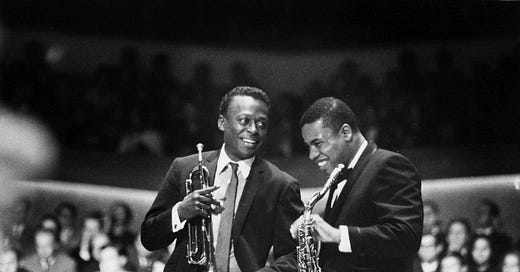


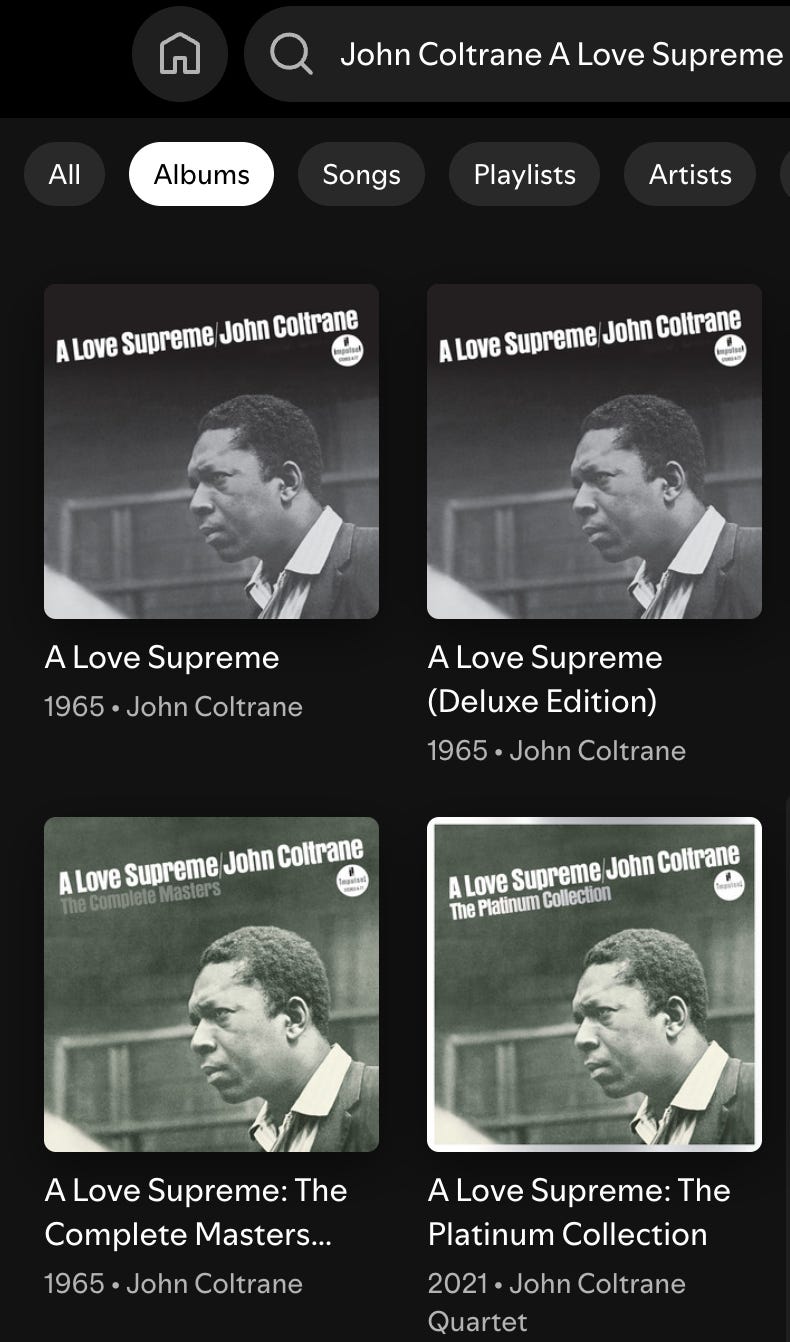



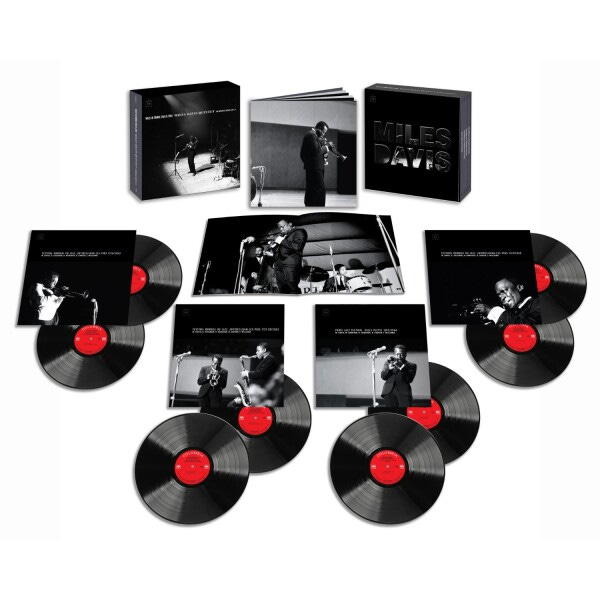

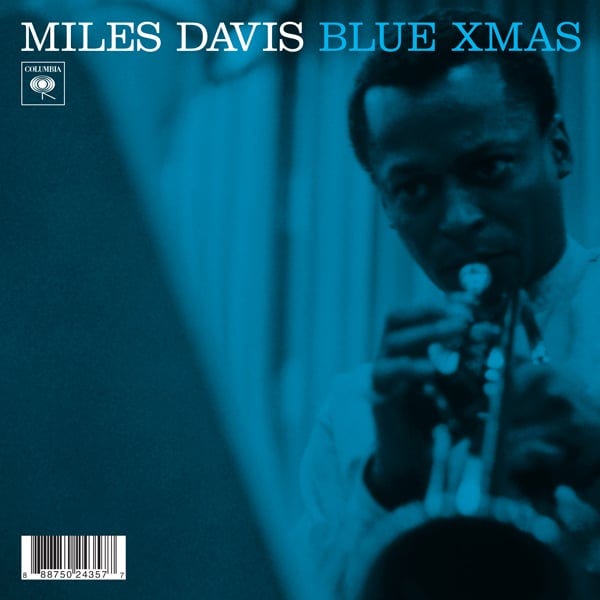
Great read x
Thanks for the typically great writeup. Fun title for your post, and for the new "reissue" as well. Miles's quote about issuing the glut from the vaults "after I'm dead" was so spot on, Miles knew. This one might have been the first time all the material from 5/26/58 was issued in one place: https://www.discogs.com/master/285470-Miles-Davis-1958-Miles